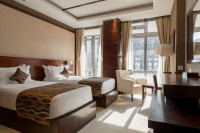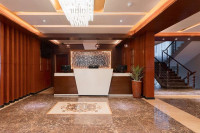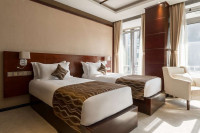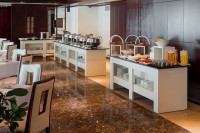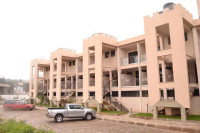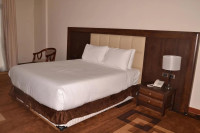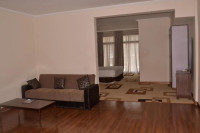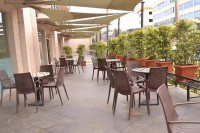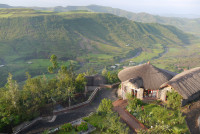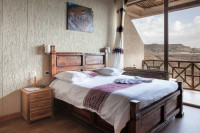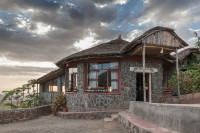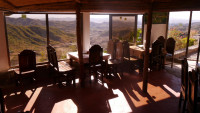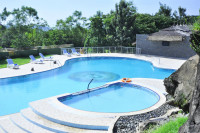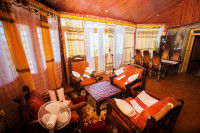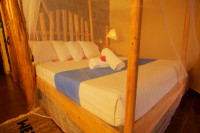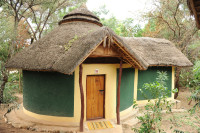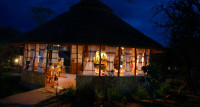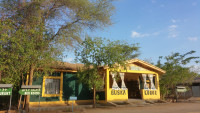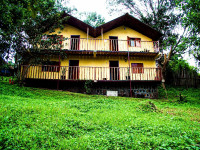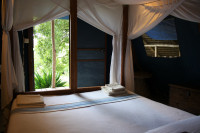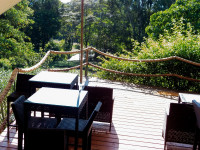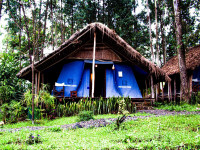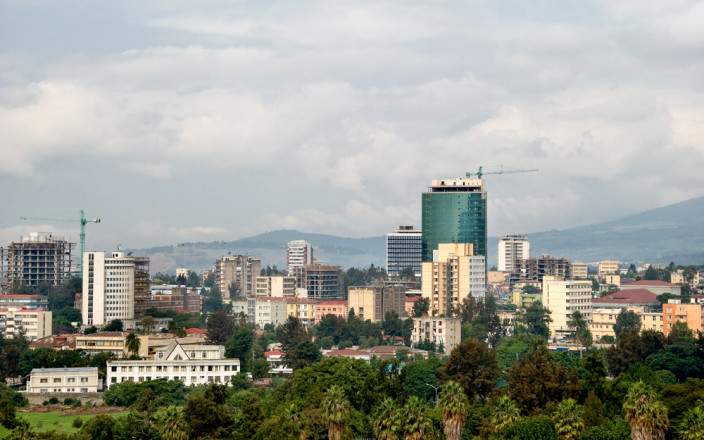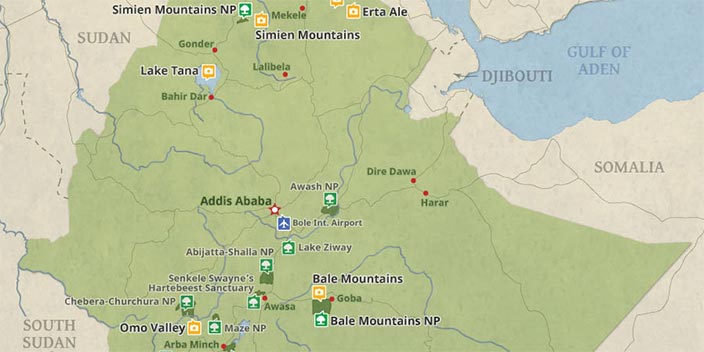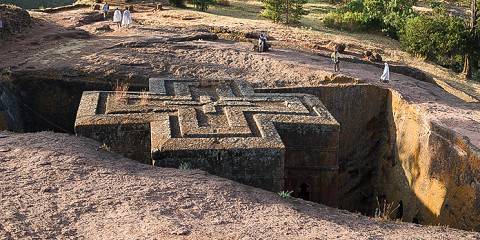
$5,500 to $5,720 pp (USD)
2 travelers on Start dateArrival
Arrival

Day 1
Welcome to Addis Ababa, Ethiopia
Welcome to Addis Ababa, Ethiopia
Upon arrival, you’ll be warmly greeted and escorted to the Best Western plus Hotel, ideally located near the Airport. Situated at an altitude of 8,200 feet above sea level in the Entoto Mountains, the Ethiopian capital is a city with a pleasant year-round climate distinguished by its wide avenues and lovely jacaranda trees. We begin our sightseeing atop Mt. Entoto for a sweeping view and introduction to the city. At the National Museum, we’ll discover an expansive collection including medieval artifacts, memorabilia of former rulers like Emperor Haile Selassie, and an exhibit of Ethiopian art from the traditional to the contemporary. But the Museum, of course, is best known as the home of Lucy; for security reasons, we’ll see a replica of this famous 3-million-year-old hominid fossil, discovered in Ethiopia in 1974, and learn about its far-reaching impact on our understanding of human origins.
- Main Destination:
- Addis Ababa (City)
- Accommodation:
- Best Western Plus Pearl Addis
- Meals & Drinks:

Day 2
From Addis Ababa to Harar
From Addis Ababa to Harar
We’ll fly from the capital to Dire Dawa where we’ll continue overland to Awaday – distinguished as the center of Ethiopia’s Khat trade.
Our journey then continues to Harar, revered as the fourth Holiest city after Mecca, Medina and Jerusalem. On arrival, we’ll find lively streets, labyrinthine alleys and a remarkable architectural assemblage. Along with more than 180 mosques and shrines, three of which date to the 10th century, you’ll see exceptional homes that reflect a myriad of influences from coastal Arabia to the wooden balconied houses of 19th-century Indian merchants.
This evening, we’ll meet one of Harar’s celebrated Hyena Men. In a tradition that is passed from father to son, Abbas Yusuf and his peers have learned to feed these wild animals directly from their mouth.
- Main Destination:
- Harar (Town)
- Accommodation:
- Grand Gato Hotel
- Meals & Drinks:

Day 3
Sightseeing in Harar
Sightseeing in Harar
The unique houses of Harar are one of the city’s most distinctive features, and we’ll continue our sightseeing today by spending time with a resident family in their traditional home. Entered through a beautifully carved door, we’ll find a welcoming residence of exceptional interior design centered on a living room that is elaborately adorned with dozens of household items – most notably the colorful baskets for which Harar is famed.
At the Harari City Museum, set in a balconied mansion where Emperor Haile Selassie spent much of his childhood, we’ll find a diverse historical collection including antique Islamic manuscripts, Harari coins minted more than 200 years ago, traditional clothing, and old musical instruments. We’ll also visit the unusual tomb of Emir Nur, the ruler who built the ancient walls of the city.
- Main Destination:
- Harar (Town)
- Accommodation:
- Grand Gato Hotel
- Meals & Drinks:

Day 4
Back to Addis Ababa
Back to Addis Ababa
Departing Harar this morning, we’ll travel back to Dire Dawa for our return flight to Addis Ababa – and another night at Best Western plus addis Hotel.
Upon arrival check back into your hotel, enjoy the amenities; indulge in shopping or optional spa treatments.
- Main Destination:
- Addis Ababa (City)
- Accommodation:
- Best Western Plus Pearl Addis
- Meals & Drinks:

Day 5
Ancient Rock-Hewn Churches of Lalibela
Ancient Rock-Hewn Churches of Lalibela
After breakfast, you’ll be escorted to the airport for your included flight into the mountains of northern Ethiopia, where the 11 cave churches of Lalibela bear witness to the extraordinary vision of an 11th-century king. Seeking to create a New Jerusalem after Muslim conquests halted Christian pilgrimages to the Holy Land; King Lalibela excavated these monolithic churches below ground level. Hewn from enormous blocks of solid granite, these churches are connected to one another by an extensive system of trenches and ceremonial passages, some with openings to ancient hermit caves and catacombs. These churches were then further embellished with stone-carved entry ways, windows, columns and other decorative elements including mural paintings.
With its five aisles, Biete Medhani Alem is believed to be the largest cave church in the world. Biete Giorgis has a remarkable cruciform floor plan distinct from the other rock-hewn churches.
- Main Destination:
- Lalibela (Town)
- Accommodation:
- Sora Lodge Lalibela
- Meals & Drinks:

Day 6
Exploring Lalibela
Exploring Lalibela
After breakfast, we’ll enjoy a guided visit to Yemrehanna Kristos, an Axumite church that predates the nearby cave churches by nearly a century. Named for a 11th century ruler of the once-mighty Axumite Kingdom, this ancient church is built inside a natural cavern in the mountain ridges below Mount Abune Yosef, one of the country’s 3rd heights peaks. Its construction is quite unusual, built with alternating layers of recessed timber beams and projecting plastered stone. The windows are embellished with carved cruciform lattices and the entire interior is decorated with geometric carvings and paintings.
After lunch, our guided exploration of Lalibela’s other rock-hewn churches continues fascinating narration and cultural insights.
- Main Destination:
- Lalibela (Town)
- Accommodation:
- Sora Lodge Lalibela
- Meals & Drinks:

Day 7
Fly to Arba Minch
Fly to Arba Minch
After breakfast, we’ll head to the airport for our included flight back to Addis Ababa where we connect with the onward flight into southern Ethiopia. On arrival in Arba Minch, we’ll be escorted to the Paradise Lodge, where thatched bungalows and private verandahs offer wonderful views over the forests and lakes of the region.
- Main Destination:
- Arba Minch (City)
- Accommodation:
- Paradise Lodge
- Meals & Drinks:

Day 8
Lake Chamo + Chencha
Lake Chamo + Chencha
Lake Chamo is home to hippos, a remarkable variety of birds and enormous crocodiles that grow to more than 18 feet in length – among the largest ever recorded. This morning after breakfast, we’ll embark on a guided boat expedition across the waters of Lake Chamo to search for these amazing wildlife inhabitants!
After lunch, we travel into the Guge Hills north of Arba Minch to Chencha, a highland village of the Dorze. This group is especially known for their unique bee-hive shaped homes which they build from local materials including hard wood poles, woven bamboo, enset leaves (false banana) and other natural materials gathered from the mountains. With expert insight from our guide, we’ll observe and even experience various facets of daily life – from the crops the villager’s plant and the foods they eat to the colorful cotton textiles they weave.
- Main Destination:
- Arba Minch (City)
- Accommodation:
- Paradise Lodge
- Meals & Drinks:

Day 9
Highlands of the Konso Tribe + Onward to Turmi
Highlands of the Konso Tribe + Onward to Turmi
After breakfast, we’ll check out and travel into the scenic highlands to spend time with the Konso people who live in unusual walled towns and settlements strategically built on hilltop plains and summits. Here we’ll learn about living cultural traditions that stretch back more than 400 years. Konso villages are partitioned into separate communities with each community having a main hut. The entire enclave can be entered only through a limited number of gates and a series of maze-like alleys provide added security.
Surrounding these settlements, we will see extensive dry-stone terraces that bear witness to the generations of Konso who have struggled to grow their crops of sorghum and grains in an inhospitable region of hard, dry rocky soil. These terraces protect valuable soil from erosion, collect water and create the terraced fields that have allowed the Konso to live here for centuries.
- Main Destination:
- Turmi (Lower Omo Valley)
- Accommodation:
- Buska Lodge
- Meals & Drinks:

Day 10
Tribes of the Omo River, eastern shores
Tribes of the Omo River, eastern shores
Today’s guided exploration introduces us to two of the groups that live along the eastern banks of the Omo River. In the morning, we spend time with the Karo.
In the afternoon, your guide will introduce you to the life and culture of the Hamer; living in distinctive huts made of wood, straw and mud, the Hamer subsist with cattle herding and agriculture. The women are known for their colorful dress and elaborate jewelry made from beads and cowrie shells. Hamer men are celebrated for their traditional bull jumping, a rite of passage that is part of an event that can last three days. The man must jump over a line of 10 to 30 bulls several times without falling. If the task is completed, the young man joins the ranks of the Maza, other men who have successfully completed the bull-jumping.
- Main Destination:
- Turmi (Lower Omo Valley)
- Accommodation:
- Buska Lodge
- Meals & Drinks:

Day 11
Omorate + Onward to Jinka
Omorate + Onward to Jinka
Departing from our lodge after breakfast, we’ll travel overland to Omorate, a riverside town deep in the lower Omo Valley. From here we cross the river to immerse in the lives and customs of the people who have lived for millennia here along the Omo’s western shores.
Also known as the People of the Delta, the Dassanech are cattle herders, farmers and fishermen. Unlike southern Ethiopia’s other, the Dassanech are not defined by ethnicity and members come from the many different ethnic groups that inhabit the region. There are eight clans that comprise the Dassanech, each having its own name; these include the Elele, Koro and Inkoria. Each clan is defined by its territory, with the Inkabelo being the wealthiest of the eight clans. As we spend time with the various Dassanech clans, we’ll gain deep insight into their daily lives and some of their unique cultural traditions related to fertility and marriage.
- Main Destination:
- Jinka (Lower Omo Valley)
- Accommodation:
- Eco Omo Lodge
- Meals & Drinks:

Day 12
The Ways of the Mursi + Back to Addis Ababa
The Ways of the Mursi + Back to Addis Ababa
Situated on the eastern banks of the Omo River and bisected by the Mago River, a tributary of the Omo, Mago National Park is a remote sector of Africa’s Great Rift Valley, home to the Mursi.
Heading out from our lodge in Jinka, we’ll travel deep into the National Park to spend time with Mursi villagers. The women of Mursi adorn their faces and bodies with white paint and from the age of 15 or 16 also wear pottery or wood discs in their lower lips. Through the years, larger and larger plates are inserted causing the lip to stretch. By old custom, the larger the lip plate, the more the women is worth before marriage. Although this practice is an integral part of their heritage and tradition, the plates are worn for only short periods of time as they are heavy and uncomfortable. The men of the Mursi also use white paint on their bodies and faces and are widely known for their fierce ceremonial dueling with a donga, a long wooden pole.
- Main Destination:
- Addis Ababa (City)
- Accommodation:
- Best Western Plus Pearl Addis
- Meals & Drinks:

Day 13
A Final Day in Addis Ababa
A Final Day in Addis Ababa
This morning is yours to enjoy as you wish. If you have last-minute gifts or souvenirs to purchase, the open-air Merkato market offers a great place to shop. In the afternoon, check out from your hotel and visit the Ethnological Museum. Set in Haile Selassie’s former palace and surrounded by the lovely gardens and fountains of Addis Ababa University, the museum’s vast and well-curated collection of artifacts and handicrafts promises a fascinating overview of Ethiopia’s diverse groups and their distinctive cultural traditions. After sightseeing, we’ll take you to the airport… Bid farewell to your guide and board your homeward flight.
- Main Destination:
- Addis Ababa (City)
- Accommodation:
- No accommodation (End of tour)
- Meals & Drinks:


